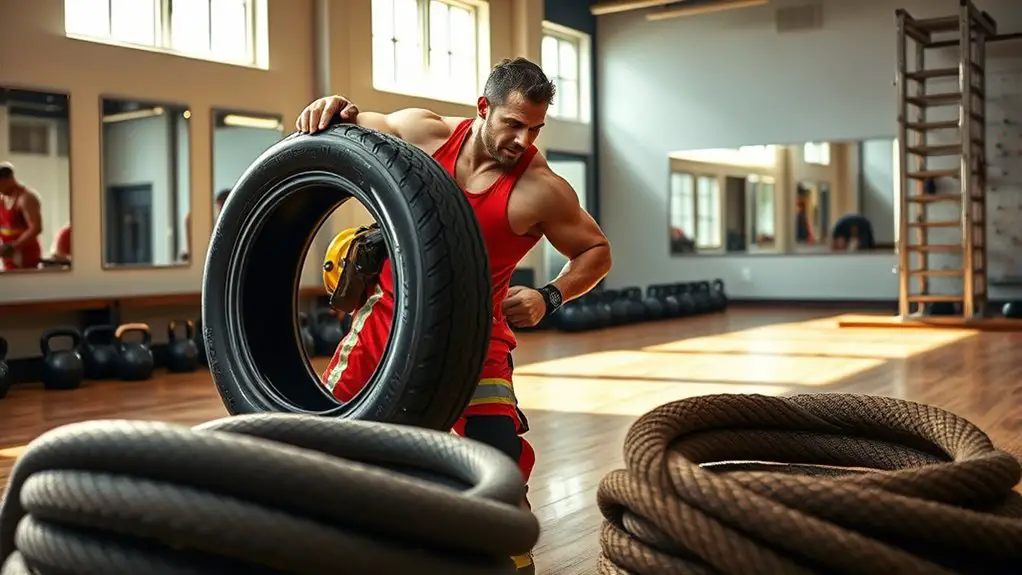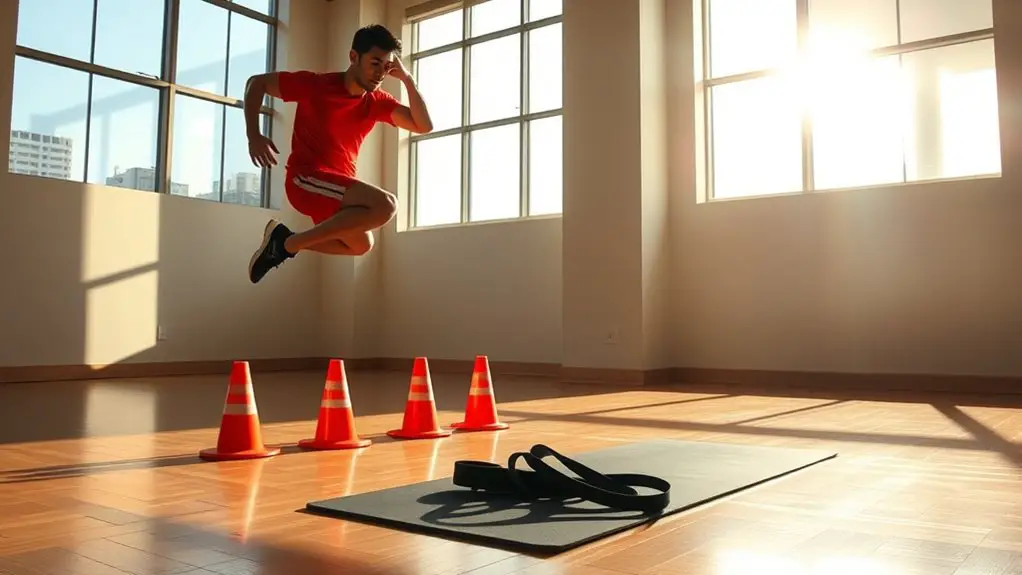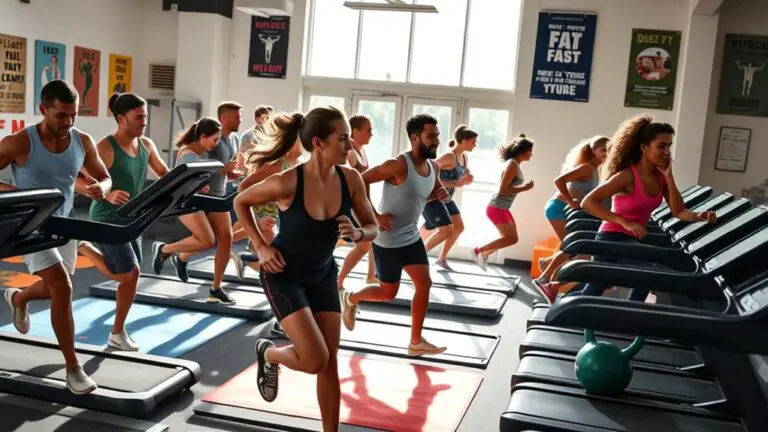How to Train Like a Firefighter at the Gym

To train like a firefighter at the gym, focus on functional fitness that mimics real-life demands. Incorporate key exercises like kettlebell swings, squats, and deadlifts to build strength. Don’t forget cardiovascular conditioning through interval training or steady-state cardio, like running or cycling. Add agility and flexibility drills to enhance quick reflexes and prevent injuries. By following these principles, you can craft a firefighter-inspired workout plan that boosts your performance and overall fitness. Discover more ways to optimize your training next!
The Importance of Functional Fitness

When it comes to training like a firefighter, understanding the importance of functional fitness is essential. This form of fitness focuses on exercises that mimic everyday movements, which helps you develop functional mobility and strength endurance. By training your body to move efficiently and effectively, you’re better prepared to handle the physical demands of firefighting.
Functional fitness workouts prioritize core stability, balance, and coordination, ensuring you can maneuver safely through unpredictable environments. You’ll want to engage in exercises that enhance your ability to lift, carry, and climb, as these actions are critical in emergency situations. Moreover, incorporating exercises like skipping rope can significantly aid in reducing belly fat, which is beneficial for overall fitness and performance.
Improving your strength endurance means you can sustain intense physical activity for longer periods, which is necessary during long firefighting operations. By incorporating functional fitness into your routine, you’re not just building muscle; you’re increasing your overall safety and preparedness on the job.
Key Exercises to Build Firefighter Strength
When you’re training like a firefighter, focusing on key exercises is essential for building strength. You’ll want to incorporate functional strength training, cardiovascular endurance workouts, and core stability exercises into your routine. These elements will help you perform at your best when it matters most.
Functional Strength Training
To build the functional strength needed for firefighting, it’s essential to focus on exercises that mimic the physical demands of the job. Incorporate movements that enhance your functional mobility and strength endurance. Exercises like kettlebell swings, deadlifts, and squats improve your lifting capability while reinforcing proper form. Engaging in compound movements, such as bench presses and overhead presses, helps develop overall body strength. Don’t forget to include core-strengthening exercises like planks and medicine ball rotations, which are vital for stability during emergency situations. Aim for a mix of heavy lifting and higher-rep workouts to develop both raw power and endurance. Remember, safety is key, so always use proper techniques and listen to your body to prevent injuries.
Cardiovascular Endurance Workouts
Building functional strength is only one part of becoming a well-rounded firefighter; cardiovascular endurance is just as important. To effectively prepare for the demands of firefighting, you should focus on workouts that enhance your stamina and heart health. Incorporating interval training into your routine can greatly boost your endurance. Here are some key exercises to take into account:
- High-Intensity Interval Training (HIIT): Short bursts of intense effort followed by recovery periods.
- Running or Cycling: Engage in longer endurance challenges to build your aerobic capacity.
- Rowing: A full-body workout that targets multiple muscle groups while improving cardiovascular fitness.
Core Stability Exercises
While it’s essential to develop cardiovascular endurance, core stability exercises are equally important for firefighters. A strong core helps you maintain balance and stability in challenging situations, reducing the risk of injury. Core stability benefits include improved posture, enhanced performance, and the ability to lift heavy equipment safely. Incorporate core strength drills like planks, Russian twists, and medicine ball throws into your routine. These exercises not only target your abs but also engage your back and hips, critical for the dynamic movements firefighters often perform. By focusing on these core stability exercises, you’ll build the strength and resilience needed to face the demands of firefighting while prioritizing safety and effectiveness. Stay strong, stay safe!
Cardiovascular Conditioning for Firefighters
Cardiovascular conditioning is essential for firefighters, as it directly impacts their ability to perform under extreme physical and mental stress. Improving your aerobic capacity enhances heart health and helps you handle the demands of firefighting. Here are some effective ways to boost your cardio fitness:
- Interval Training: Incorporate high-intensity intervals to build endurance and strength.
- Steady-State Cardio: Engage in activities like running, cycling, or swimming for longer durations to enhance stamina.
- Functional Workouts: Use exercises that mimic firefighting tasks, like stair climbs or sled pulls, to improve overall fitness.
Incorporating Agility and Flexibility Training

Agility and flexibility are essential for firefighters, helping you maneuver through tight spaces and react swiftly in emergencies. Incorporating specific flexibility exercises and dynamic stretching routines can enhance your performance on the job. Let’s explore how you can effectively integrate these elements into your training.
Importance of Agility Training
When it comes to firefighting, being quick on your feet can make all the difference in high-pressure situations. Agility training is essential for developing those quick reflexes that can help you navigate obstacles and respond effectively during emergencies. By incorporating agility drills into your workout routine, you’ll enhance your overall performance and safety.
- Improved reaction times: You’ll be better prepared to make split-second decisions.
- Enhanced coordination: You’ll move more fluidly, reducing the risk of injury.
- Increased confidence: You’ll feel more capable in challenging scenarios.
Focusing on agility not only prepares you physically but also mentally, ensuring you’re ready for whatever comes your way on the job. Prioritize agility training to stay sharp and safe.
Flexibility Exercises for Firefighters
Flexibility exercises are essential for firefighters, as they complement agility training by enhancing your range of motion and preventing injuries. Incorporating regular yoga routines can help improve your flexibility, balance, and overall mental focus. Consider adding mobility drills to your regimen, which target specific joints and muscle groups vital for firefighting tasks. Movements like hip openers, shoulder stretches, and spine twists can enhance your ability to maneuver effectively in tight spaces while maintaining safety. You’ll find that as your flexibility improves, so does your performance during high-stress situations. Remember, a well-rounded approach to training, including flexibility exercises, not only boosts your agility but also greatly reduces the risk of injury on the job. Stay safe and limber!
Incorporating Dynamic Stretching Routines
Building on the foundation of flexibility exercises, incorporating dynamic stretching routines can greatly enhance your agility and overall performance as a firefighter. Dynamic warm-ups prepare your body for the demands of training, reducing the risk of injury. These routines not only improve flexibility but also increase blood flow and mobility, ensuring you’re ready for action.
Here are some effective dynamic stretching routines to include in your training:
- Leg Swings: Helps improve hip mobility and leg strength.
- Arm Circles: Increases shoulder flexibility and range of motion.
- Walking Lunges: Engages core muscles while promoting lower body strength.
Creating a Firefighter-Inspired Workout Plan

How can you create a workout plan that mirrors the demands of a firefighter’s job? Start by focusing on functional movements that build strength, endurance, and agility. Incorporate exercises like kettlebell swings, squats, and deadlifts to enhance your overall power. Don’t forget to include cardio workouts, such as running or rowing, to boost your stamina.
Moreover, firefighter nutrition plays an essential role in your training. Fuel your body with balanced meals rich in protein, healthy fats, and complex carbs to support your workouts. After exercising, prioritize workout recovery through proper hydration and stretching to prevent injuries and guarantee muscle repair.
Tips for Staying Motivated and Consistent
Staying motivated and consistent with your firefighter-inspired workout plan can be just as challenging as the training itself. To help you stay on track, focus on goal setting and workout accountability. Here are a few tips to keep your fire burning:
- Set SMART Goals: Specific, Measurable, Achievable, Relevant, and Time-bound goals will give you direction and purpose.
- Find a Workout Buddy: Training with someone else keeps you accountable and adds a social element, making workouts more enjoyable.
- Track Your Progress: Use a journal or app to log your workouts, celebrate milestones, and identify areas for improvement.
Frequently Asked Questions
What Should I Eat to Support My Firefighter Training?
To support your training, focus on meal prepping to guarantee you have nutritious options readily available. Incorporate lean proteins, whole grains, and plenty of fruits and vegetables to fuel your workouts. Don’t forget about nutrient timing; eating a balanced meal or snack before and after training can enhance your performance and recovery. Staying hydrated is vital too, so keep water handy. Prioritize safety by choosing whole foods and avoiding processed snacks.
How Often Should I Train Each Week?
When considering your training frequency, aim to work out at least four to five times a week. This helps build endurance, strength, and agility essential for safety. A balanced workout schedule should include strength training, cardio, and flexibility exercises to prepare your body for various challenges. Don’t forget to incorporate rest days to allow for recovery, which is just as important for maintaining your overall well-being and preventing injuries.
Can I Train Like a Firefighter if I’m a Beginner?
You might think firefighter training’s only for the experienced, but you can absolutely start as a beginner! Focus on fitness basics like bodyweight exercises, light weights, and cardio. Beginner workouts can be tailored to your level, ensuring you build strength and endurance safely. Always listen to your body, and gradually increase intensity as you progress. With consistency and the right approach, you’ll be well on your way to achieving your fitness goals!
What Equipment Do I Need for Firefighter-Style Workouts?
If you’re looking to gear up for firefighter-style workouts, you’ll want some essential equipment. Kettlebell swings are fantastic for building strength and endurance, so grab a kettlebell that suits your fitness level. Battle ropes are another great addition; they’ll help improve your cardiovascular fitness and upper body strength. Remember to prioritize safety—start with lighter weights and focus on your form to avoid injuries. You’re setting yourself up for success!
How Can I Prevent Injuries While Training?
Training without precautions is like driving a car with no seatbelt—you’re asking for trouble. To prevent injuries, always start with proper warm-ups to prepare your body. Focus on dynamic stretches and light cardio to get your muscles ready. Incorporate recovery techniques, like foam rolling and adequate rest, to help your body heal. Pay attention to your limits, and don’t push through pain; it’s essential for maintaining long-term safety and performance.





